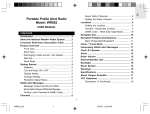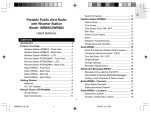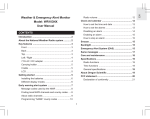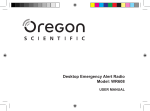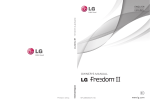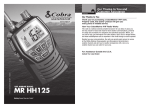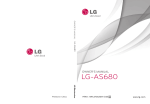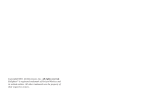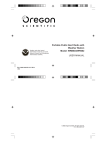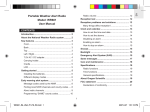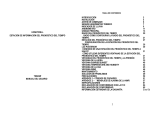Download User Manual - Weather Radio Store
Transcript
Clock ..................................................................... 10 Alarm ..................................................................... 10 Music from external audio device .......................... 11 AM/FM ....................................................................... 11 Recharging ............................................................... 11 Solar power ........................................................... 11 Crank ..................................................................... 12 Electricity from adapter ......................................... 12 Emergency siren...................................................... 12 Flashlight.................................................................. 12 Backlight .................................................................. 12 Key Lock................................................................... 12 Reset ......................................................................... 12 Specifications .......................................................... 13 Precautions .............................................................. 13 About Oregon Scientific ......................................... 14 FCC Statement ......................................................... 14 Declaration of conformity ...................................... 15 Appendix .................................................................. 15 Same Code - What each digit means .................. 15 List of NOAA messages ........................................ 17 USER MANUAL CONTENTS Introduction................................................................ 2 About the National Weather Radio System............. 2 Consumer Electronics Assoc. (CEA)....................... 2 Overview..................................................................... 3 Front view ................................................................ 3 Back view ................................................................ 4 LCD Display ............................................................ 4 Power source ............................................................. 5 Back-up power ........................................................ 5 Rechargeable battery .................................................. 5 Navigating through settings / displays ................... 5 NOAA weather radio.................................................. 6 Finding local channels and SAME codes ................ 6 Setting the radio channel ........................................ 6 Setting the location / SAME code ............................ 7 NOAA reception ......................................................... 8 Reception signal status ........................................... 8 Reception test ......................................................... 9 Many things affect reception! .................................. 9 Receiving NOAA alert messages ............................. 9 General settings ...................................................... 10 EN Multi-Powered Emergency Radio + Area Specific Hazard Alerts Model:WR203 1 WR203_MANUAL.indd 1 10/26/11 12:33:12 EN Working in conjunction with the Emergency Alert System (EAS), NWR is an all-in-one hazards radio network and is considered to be the single source of all comprehensive weather and emergency information. INTRODUCTION Listen to broadcasts and receive alerts issued by the National Weather Service in real-time. Using the built-in area specific technology (SAME), customize the alerts for your specific county or region. A nationwide network, the NWR consists of more than 1000 stations in the United States, Puerto Rico, the US Virgin Islands and US Pacific Territories. Broadcasts are designed to meet local needs. Routine programming is repeated every few minutes and consists of local forecast, regional conditions and marine forecasts. Enjoy listening to your personal music collection by simply plugging-in or alternatively tune into your favorite radio station. With clock and alarm, keep track of time and wake up bright and ready for a new day of exploring and enjoying the natural surroundings. With the addition of an emergency siren, flashlight and ability to charge your mobile phone, this Multi-Powered Emergency Radio is a must-have item for your outdoor adventures. Additional information, including river stages and climatic data, is also provided. During emergencies, these routine broadcasts are interrupted to report specific warnings. CONSUMER ELECTRONICS ASSOC. (CEA) Keep this manual handy as you use your new product. It contains practical step-by-step instructions as well as technical specifications and warnings you should know about. This product complies with the Consumer Electronics Association (CEA) standards. ABOUT THE NATIONAL WEATHER RADIO SYSTEM The National Weather Service (NWS) is an agency within the National Oceanic & Atmospheric Administration (NOAA) that operates a nationwide network of radio stations known as the NOAA Weather Radio (NWR). The NWR radio system broadcasts warning information for all types of hazards, both natural and technological. 2 WR203_MANUAL.indd 2 10/26/11 12:33:13 7. FRONT VIEW : decrease / increase value of the setting; adjust volume (1-7) for NOAA radio 8. : activate / deactivate NOAA function (turn off NOAA display); toggle between NOAA On / Standby / Mute / Off; switch NOAA ON (from mute mode) if SAME message received 9. : toggle between SAME messages; lock / unlock keypad EN OVERVIEW 10. Public Alert indicator: green light to indicate NOAA broadcasts are being received (NOAA On / Standby / Mute mode); red to indicate Watch / Warning message received 11. Crank : wind to charge battery or mobile phone 1 2 3 4 5 6 12. LED indicator : continuous red light to indicate unit / mobile phone is charging; flashing red light to indicate rechargeable batter is low; green light to indicate radio is on 7 8 9101112 1. VOL knob: adjust volume (0-7) for AM/FM radio 2. 3. : turn emergency alarm on/off : turn radio on/off and toggle between AM/FM 4. : auto search / adjust AM/FM radio frequency 5. : exit setting mode; return to default clock display 6. : toggle between clock / calendar / alarm 1 and 2 displays; set clock; confirm clock setting 3 WR203_MANUAL.indd 3 10/26/11 12:33:13 EN LCD DISPLAY BACK VIEW 1 2 3 4 5 6 7 8 9 1 2 3 4 5 10 1. 6 7 8 9 10 11 1. Solar panel 2. SNOOZE : activate snooze alarm / backlight : Weather radio channel (1-7 or Auto) : NOAA radio On; NOAA radio reception status 3. : NOAA Standby 4. : NOAA Mute (only messages will be displayed) : keypad is locked 7. STATE / COUNTY: Name or Code of State / County 6. Headphone jack 8. 7. Audio line-in jack 8. DC adapter jack : alarm 1 / 2 is enabled or setting is displayed 9. CHANNEL / LOCATION / ALARM / CLOCK: indicates type of information displayed 9. Mobile phone charger jack and charger switch 10. Battery compartment WR203_MANUAL.indd 4 13 2. 6. : turn flashlight on/off 5. Light 11. RESET : return unit to default settings 12 5. Indicates the type of message displayed 3. Antenna 4. 11 10. : radio is on and AM/FM is selected 4 10/26/11 12:33:15 12. Radio frequency / volume 13. EN 3. Align holes in the connector with the pins, then push connector in. 11. Clock / calendar / message : back-up battery level indicator POWER SOURCE BACK-UP POWER In cases where rechargeable battery power is low or has no power, the unit will source its energy from the back-up batteries. Insert 3 AAA batteries: 1. Slide open battery compartment. 2. Insert the batteries matching the polarities. indicates there is no back-up battery or back-up battery is low. 4. Tuck wires in and ensure they are within the battery compartment area. It is recommended to insert back-up batteries in case of power shortage during emergencies. 5. Close battery compartment cover. RECHARGEABLE BATTERY NAVIGATING THROUGH SETTINGS / DISPLAYS This radio has a built-in rechargeable battery that can store energy from different sources: a solar panel, a manual hand crank or electricity via an adapter (not included in package). After inserting batteries, the unit will automatically prompt you to set the clock. (Go directly to ‘Clock’ section, step 4). There are 4 settings that need to be set: Alarm / Clock / Channel / Location. When rechargeable battery level is low, red LED indicator light will flash. 1. Press 1. Remove battery compartment cover. 2. Press 2. Insert battery pack. to enter setting mode. to navigate to desired setting. 5 WR203_MANUAL.indd 5 10/26/11 12:33:17 EN To quick exit, press For example, clicking on “Montana” will give a list of information relevant to the State of Montana including the names of counties, SAME codes, NWR transmitter locations, the frequency of the transmitter, the strength of the signal in WATTS, and any remarks as applicable. . To toggle between displays: Press . Display options: clock / calendar / alarm 1 and 2. Example of the first 10 county radio channels and SAME codes: NOAA WEATHER RADIO With this unit, you can listen to weather broadcasts and view alert messages issued by the National Weather Service. First, find your local channel and SAME code and using this information set the channel and location on the unit. COUNTY SAME# NWR TRANS MITTER Beaverhead 030001 Butte,MT Beaverhead 030001 Dillon,MT Big Horn 030003 Billings,MT Blaine 030005 Havre, MT Blaine 030005 Billings MT Broadwater 030007 Helena, MT Carbon 030009 Billings MT Carter 030011 Baker, MT Cascade 030013 Great Falls, MT Chouteau 030015 Miles Hill, MT FINDING LOCAL CHANNELS AND SAME CODES National Weather Service uses one of 7 preset radio frequencies for their NOAA Weather Radio transmitters across the country. Please refer to the below phone number and website link to find the right channel and SAME* code for your local county: * For more information about SAME code, refer to appendix 1. CALL CHOOSE RADIO CHANNEL 162.550 WXL79 7 162.475 WNG638 4 162.550 WXL27 7 162.400 WXL53 1 162.475 WWG85 4 162.400 WXK66 1 162.550 WXL27 7 162.550 WXK57 7 162.550 WXJ43 7 162.500 WWG84 5 SETTING THE RADIO CHANNEL To contact the NWS by telephone: After identifying the frequency of your local NOAA Weather Radio transmitter, refer to below table to find the corresponding channel (1-7). 1. Phone 1-888-NWR-SAME (1-888-697-7263). 2. Follow prompts through a simple voice menu. 1. Press and hold To obtain NWS radio channels on the internet: 2. Press 1. Locate www.nws.noaa.gov/nwr/indexnw.htm 3. Press 2. Click the State for which information is needed. 6 WR203_MANUAL.indd 6 FREQ MHZ 4. Press to enter setting mode. to navigate to Set Channel. to enter. to select channel (Auto, 1-7). 10/26/11 12:33:18 select “ALL” (receive all warnings) or “---“ (disable the ALL option), press to confirm selection. Continue setting the other storage locations: 5. Digit next to C will flash. Press to select where you want to store the location, e.g., C1. Press to confirm. The 6 digits will flash. , NAME / FIPS will flash. (Select either 6. Press option a or b below) a. SETTING THE LOCATION / SAME CODE This unit can store up to 9 locations (1-9). NOTE If you select “CO:All” (step 3 below) you will receive all warnings within the unit’s reception range. This may result in giving you information for regions that are not relevant. The regions can be as large as 5,000 square miles (13 sq km). If you select “CO:--“ you will disable the ALL option and will only receive warnings from specified local areas. 2. Press 3. Press WR203_MANUAL.indd 7 Press to navigate to state and press to confirm. Repeat for county b. To program by SAME code from the NWS: i. to navigate to FIPS and press Press to enter setting options. ii. Press and press digit. repeatedly to select number to confirm and move to the next iv. After all digits have been confirmed, storage location (e.g., C1) will flash. Press to navigate to next storage location and press to confirm. Repeat steps ii - iv. to navigate to Set Location. to enter. , to to enter setting options. Press ii. iii. Repeat step ii for all digits. to enter setting mode. 4. “CO:ALL” or “CO:--“ will be displayed. Press characters on the right will flash. Press To program by State / County name: i. iii. Press to navigate to next storage location (e.g., C2) and press to confirm. Repeat steps i-iii. NOTE If you do not set a location, the radio will use the default setting “CO:All” for all counties. 1. Press and hold EN Examples of which radio to choose for a particular location is given in the far right column in above chart. CHANNEL CORRESPONDING RADIO FREQUENCY 1 162.400 MHz 2 162.425 MHz 3 162.450 MHz 4 162.475 MHz 5 162.500 MHz 6 162.525 MHz 7 162.550 MHz 7 10/26/11 12:33:19 EN 4. Press to navigate to a stored location, e.g., C4 and press . NOTE Once the location name is selected, the corresponding FIPS code will be set into the memory. You cannot convert the code back to the location name. (FIPS is the Federal Information Processing System number assigned to each State, or open waters in or around the US. The SAME code comprises of numbers generated by the FIPS system.) 5. When 6 digit SAME code or “---“ is blinking, press to activate or deactivate it and press to confirm the setting. NOAA RECEPTION Activate / deactivate location: You can activate / deactivate 1, some, or all of your stored locations. When a location is activated, the 6-digit SAME code can be viewed in your stored locations display. RECEPTION SIGNAL STATUS Press NOAA to enter radio mode. Green light indicates radio is on. To change volume: Press . Reception signal status: ICON When a location is deactivated, “---“ can be viewed in your stored locations display. 1. Press and hold 3. Press to enter setting mode. NOTE If NOAA radio is on, whether it be NOAA On, Standby or Mute, unit will continually search for a NOAA signal. to navigate to Set Location. 2. Press to enter. WR203_MANUAL.indd 8 DESCRIPTION Currently selected channel signal is strong Currently selected channel signal is weak No NOAA alert message has been received for 10 days. Currently selected channel signal is weak No NOAA alert message has been received for 10 days. Currently selected channel signal is strong 8 10/26/11 12:33:20 EN NOTE If NOAA function has been deactivated (top display is blank), press and hold NOAA to reactivate NOAA radio. MANY THINGS AFFECT RECEPTION! Forests, deserts, and hills / mountains tend to greatly reduce reception. Reception in cities may be reduced due to steel and concrete, while higher elevations will enhance the signal. Reception can vary from room to room. Moving even a few feet can enhance signal reception. RECEPTION TEST The fact that you can get clear voice reception does not guarantee that an emergency alert will trigger your unit’s alert tone. To test actual reception, your unit must receive a test or emergency alert signal broadcast. RECOMMENDATION Place the weather radio near a window, away from other electronic equipment, and on an upper level of your house. The National Weather Service (NWS) broadcasts a test alert every week on Wednesday between 10AM and 12PM (noon). To receive the test message make sure that your radio is set to NOAA ON, NOAA Standby or NOAA Mute mode, that a Channel has been selected and a SAME code programmed in. RECEIVING NOAA ALERT MESSAGES This product is equipped to receive all required NOAA and Emergency Alert System (EAS) events. When an EAS event is sent by the NWS, any 1 of the following NOAA alert messages will be displayed on your radio: “WARNING”,“WATCH”, or “ADVISORY”. The unit can store up to 8 NOAA alert messages. To find out the specific test schedule in your area, contact your local National Oceanic and Atmospheric Administration (NOAA) or National Weather Service (NWS) office. These offices are usually listed in the telephone book under “US Government”. If you have any questions regarding alarm tests or to verify if a test was conducted, contact the programming office of your local NOAA Weather Radio station. The red public alert indicator will light up if a ‘WATCH’ or ‘WARNING’ message has been received. It will continue flashing until NWS withdraws the alert message. If NWS issues an emergency warning, the siren will sound for 8 seconds to alert users. To receive a NOAA alert message, press NOAA to set the radio to one of the following options: REMEMBER For your system to be effective, you must place the emergency radio in a location where it can receive an emergency alert signal, you can hear its siren, and see its flashing indicator lights. • • : The radio is ON and voice messages Radio ON can be heard continuously. : The radio is in Standby and Radio Standby 9 WR203_MANUAL.indd 9 10/26/11 12:33:21 EN • • will switch to ON when a NOAA alert message is received. : The radio is in Standby with the Radio Mute sound turned OFF. NOAA alert messages can be viewed but not heard. Switch the radio ON to hear messages. Radio OFF: The radio is turned OFF and will not respond to NOAA alert messages. ALARM The unit has 2 alarms (alarm 1 and 2). They can be used together or independently. Alarms 1 and 2 have different sounds so that you can differentiate them. The alarm will sound for 1 minute unless it is disabled. To set the alarm(s): 1. Press and hold Alarm will appear. When not listening to NOAA radio broadcasts, turning the radio to Standby, Mute or OFF will help to save power. To view NOAA alert messages: Press 2. Press 4. Press For a list of alert messages, please refer to the appendix. The alarm icon is enabled. CLOCK 1. Press and hold 3. Press will appear when alarm 1. Press to toggle screen display until screen shows alarm 1 / alarm 2 information. to enter. 2. Press 4. Continue to set the following by repeating steps 2-3: hour format, hour, minute, calendar format (M-D / D-M), year, month, day and language (E, F, S). 3. Press to enable / disable. to confirm. -:-- means alarm is disabled. To silence the alarm: • Press SNOOZE to silence it for 8 minutes NOTE The language selected will also be used for the NOAA alert messages. WR203_MANUAL.indd 10 or To enable / disable alarm: to enter setting mode. to navigate to Set Clock. Hold to speed through the settings. to select alarm 1 or 2. to confirm selection. 5. Continue with setting the hour / minute by repeating steps 3-4. GENERAL SETTINGS 2. Press to enter. 3. Press . to enter setting mode. Set 10 10/26/11 12:33:22 EN OR • Press any key (except , ) to turn the alarm off and activate it again after 24 hours. RECHARGING SOLAR POWER Expose the solar panel directly to sunlight. TIPS • For best results when charging the battery, place the solar panel directly with view to sunlight. • Direct solar panel as follows: MUSIC FROM EXTERNAL AUDIO DEVICE NOTE NOAA weather radio has to be first turned off. Using a cable, plug one end to your music storage device and one end to audio line-in socket located at the back of the unit. Solar panel facing: if you reside in the: AM/FM North Southern Hemisphere To turn radio on / off: South Northern Hemisphere Press . Green light indicates radio is on. • To select frequency: 1. Press • again to select AM or FM. 2. Press and hold to auto search or press to manually select frequency. • • To change volume: Turn VOL knob. It takes approximately 30 hours to fully charge the battery by solar power (under strong light conditions). Do not scratch the solar panel’s surface or wipe it with strong detergent. Do not expose the solar panel to rain, snow or moisture. The duration of the rechargeable battery’s charging or operating time is determined by either the intensity of sunlight or the position of the solar panel towards the sun. Do not overcharge the batteries. NOTE When charging, even if radio is on, indicator will be red. • NOTE To listen to the radio, ensure line-in cable is not connected. NOTE Solar panel cannot be used to charge mobile phone. 11 WR203_MANUAL.indd 11 10/26/11 12:33:22 EN NOTE It takes 7 hours to fully charge the battery by using an adapter, which is not included. CRANK Mobile phones can only be charged by cranking or by adapter (separate purchase required). EMERGENCY SIREN To charge unit: Push alarm on. 1. Slide charger switch to . 2. Lift crank and wind clockwise. switch outward to turn emergency To turn alarm off, push original position. To charge mobile phone: 1. Using USB cable (not included) connect one end to the mobile phone and the other end to mobile phone charger jack. 2. Slide charger switch to select . 3. Lift crank and wind clockwise. switch back to its FLASHLIGHT Press to turn flashlight on/off. BACKLIGHT Press SNOOZE to activate backlight for 5 seconds. NOTE 1 minute of winding can power the radio for approx. 5 minutes. It would take approximately 85 minutes of continuous winding (2 turns per second) to fully charge the battery. KEY LOCK press & hold ELECTRICITY FROM ADAPTER will appear when keypad is locked. To use this feature, purchase a 5V adapter. 1. Lift the soft plastic cover located on the back of the unit. 2. Plug adapter into the unit and the other end to wall outlet. 3. Slide charger switch accordingly. RESET Press RESET (located in the back-up battery compartment) to return to default settings. charge mobile charge unit 12 WR203_MANUAL.indd 12 10/26/11 12:33:23 SPECIFICATIONS • TYPE DESCRIPTION LxWxH 7.5 x 2.1 x 3.9 in (191 x 54 x 98 mm) Weight 14.3 oz (404 g) AM radio 520 – 1710 KHz FM radio 88 – 108 MHz Battery 3 x UM-4 AAA batteries(for backup, not included) 600mAh 3.6V Ni-MH rechargeable battery DC adaptor • • • • • DC5V 500mA (not included) • PRECAUTIONS • • • • • Do not subject the unit to excessive force, shock, dust, temperature or humidity. Do not cover the ventilation holes with any items such as newspapers, curtains etc. Do not immerse the unit in water. If you spill liquid over it, dry it immediately with a soft, lint-free cloth. Do not clean the unit with abrasive or corrosive materials. Do not tamper with the unit’s internal components. WR203_MANUAL.indd 13 EN This invalidates the warranty. Only use fresh batteries. Do not mix new and old batteries. Images shown in this manual may differ from the actual display. When disposing of this product, ensure it is collected separately for special treatment and not as household waste. Placement of this product on certain types of wood may result in damage to its finish for which Oregon Scientific will not be responsible. Consult the furniture manufacturer's care instructions for information. The contents of this manual may not be reproduced without the permission of the manufacturer. Do not dispose old batteries as unsorted municipal waste. Collection of such waste separately for special treatment is necessary. Please note that some units are equipped with a battery safety strip. Remove the strip from the battery compartment before first use. NOTE The technical specifications for this product and the contents of the user manual are subject to change without notice. NOTE Features and accessories will not be available in all countries. For more information, please contact your local retailer. 13 10/26/11 12:33:23 EN is no guarantee that interference will not occur in a particular installation. If this equipment does cause harmful interference to radio or television reception, which can be determined by turning the equipment off and on, the user is encouraged to try to correct the interference by one or more of the following measures: • Reorient or relocate the receiving antenna. • Increase the separation between the equipment and receiver. • Connect the equipment into an outlet on a circuit different from that to which the receiver is connected. • Consult the dealer or an experienced radio / TV technician for help. ABOUT OREGON SCIENTIFIC Visit our website (www.oregonscientific.com) to learn more about Oregon Scientific products. If you're in the US and would like to contact our Customer Care department directly, please visit: https://us.oregonscientific.com/ service/support.asp For international inquiries, please visit: http:// us.oregonscientific.com/about/international.asp FCC STATEMENT This device complies with Part 15 of the FCC Rules. Operation is subject to the following two conditions: (1) This device may not cause harmful interference, and (2) This device must accept any interference received, including interference that may cause undesired operation. WARNING Changes or modifications not expressly approved by the party responsible for compliance could void the user’s authority to operate the equipment. NOTE This equipment has been tested and found to comply with the limits for a Class B digital device, pursuant to Part 15 of the FCC Rules. These limits are designed to provide reasonable protection against harmful interference in a residential installation. This equipment generates, uses and can radiate radio frequency energy and, if not installed and used in accordance with the instructions, may cause harmful interference to radio communications. However, there WR203_MANUAL.indd 14 14 10/26/11 12:33:23 EN DECLARATION OF CONFORMITY APPENDIX The following information is not to be used as contact for support or sales. Please visit our website at http://us.oregonscientific.com/service/ for all enquiries. SAME CODE - WHAT EACH DIGIT MEANS A SAME code is broken into 6 fields of numbers. 3 We Name: Address: Oregon Scientific, Inc. 19861 SW 95th Ave.,Tualatin, Oregon 97062 USA Telephone No.: 04 003 Code for Cochise County Code for Arizona Code for northeast sub-section of Cochise County County code for Cochise County, Arizona 1-800-853-8883 declare that the product State-county coding: Product No.: WR203 Product Name: Multi-Powered Emergency Radio The 3 digits on the far right refer to the state county coding. Each county within a state will have an independent 3-digit code. + Area Specific Hazard Manufacturer: Address: NOTE To receive all of the alerts for a given state, insert 000 into the county section. IDT Technology Limited Block C, 9/F, Kaiser Estate, State codes: Phase 1, 41 Man Yue St., Hung Hom, Kowloon, Moving towards the left, the next 2 digits are for state coding. Hong Kong Each of the 50 U.S. States has their own 2-digit code. is in conformity with Part 15 of the FCC Rules. Operation is subject to the following two conditions: 1) This device may not cause harmful interference, and 2) This device must accept any interference received, including interference that may cause undesired operation. County sub-section code: The last digit on the far left is the county subsection. A county may be sub-divided into nine sub-sections; each number between (1-9) represents a specific county sub-section. 15 WR203_MANUAL.indd 15 10/26/11 12:33:23 EN NOTE If the county sub-section code is stated as 0, then that county is not sub-divided and all alerts for that county will be received. To receive all of the alerts for a given county, insert 0 into the county sub-section. A county can be subdivided as follows: 1 2 3 4 5 6 7 8 9 Northwest North Central Northeast West Central Central East Central Southwest South Central Southeast 16 WR203_MANUAL.indd 16 10/26/11 12:33:24 EN LIST OF NOAA MESSAGES NATURE OF ACTIVATION Administrative Message Avalanche Watch Avalanche Warning Biological Hazard Warning Boil Water Warning Blizzard Warning SPANISH Mensaje administrativo Vigilancia de avalancha Aviso de avalancha Aviso de riesgo biológico Aviso de hervir agua Aviso de ventisca Child Abduction Emergency Emergencia de secuestro de menores Alerte de rapt d'enfant Aviso de peligro civil Alerte de danger civil Mensaje de emergencia civil Message d'urgence civile Vigilancia de inundaciones costeras Veille d'inondation côtière Aviso de inundaciones costeras Alerte d'inondation côtière Aviso de riesgo químico Alerte de risque chimique Alerta de Agua Contaminada Alerte de contamination de l'eau Vigilancia de represa Veille de barrage Aviso de rompimiento de represa Alerte de rupture de barrage Aviso de enfermedad contagiosa Alerte de maladie contagieuse Práctica/Demostración Exercice/demonstration Aviso de vendaval de polvo Alerte de tempête de poussière Anuncio de acción urgente Notification d'action urgente Fin de acción urgente Fin d'action urgente Aviso de terremoto Alerte de tremblement de terre Evacuación inmediata Évacuation immediate Vigilancia de evacuación Veille d'évacuation Aviso de contaminación de Alerte de contamination d'aliments alimentos ADVISORY WARNING WARNING WATCH WARNING WARNING WARNING WATCH WARNING WARNING ADVISORY WARNING WARNING ADVISORY WARNING WARNING WATCH Vigilancia de inundaciones relámpago WATCH Civil Danger Warning Civil Emergency Message Coastal Flood Watch Coastal Flood Warning Chemical Hazard Warning Contaminated Water Warning Dam Watch Dam Break Warning Contagious Disease Warning Practice / Demo Dust Storm Warning Emergency Action Notification Emergency Action Termination Earthquake Warning Immediate Evacuation Evacuation Watch Food Contamination Warning Flash Flood Watch FRENCH Message administratif Veille d'avalanche Alerte d'avalanche Alerte risque biologique Alerte d'ébullition de l'eau Alerte de blizzard Veille de crue subite MESSAGE ADVISORY WATCH WARNING WARNING WARNING WARNING WARNING 17 WR203_MANUAL.indd 17 10/26/11 12:33:24 EN NATURE OF ACTIVATION Flash Flood Statement Flash Flood Warning Flood Watch SPANISH Advertencia de inundaciones relámpago Aviso de inundaciones relámpago Vigilancia de inundación Flood Statement Flood Warning Fire Warning Flash Freeze Warning Freeze Warning Hurricane Statement Hazardous Materials Warning Hurricane Watch Hurricane Warning High Wind Watch High Wind Warning Iceberg Warning Industrial Fire Warning Local Area Emergency Law Enforcement Warning Land Slide Warning National Audible Test Advertencia de inundación Aviso de inundación Aviso de incendio Aviso de helada repentina Aviso de helada Advertencia de huracán Aviso de materiales peligrosos Vigilancia de huracán Aviso de huracán Vigilancia de vientos fuertes Aviso de vientos fuertes Aviso de témpano de hielo Aviso de incendio industrial Emergencia de área local Aviso de las autoridades de la ley Aviso de deslizamiento de tierra Prueba nacional de audibilidad Mensaje del National Information Center Anuncio de mensaje en red Prueba periódica nacional Prueba nacional de silencio Aviso de riesgo nuclear Notificación de interrupción eléctrica National Information Center Network Notification National Periodic Test National Silent Test Nuclear Power Plant Warning Power Outage Advisory FRENCH MESSAGE Bulletin spécial de crue subite Alerte de crue subite Veille d'inondation Bulletin spécial de risque d'inondation ADVISORY WARNING WATCH Alerte d'inondation Alerte de feu Alerte de gel soudain Alerte de gel Avis d'ouragan Alerte de matières dangereuses Veille d'ouragan Alerte d'ouragan Veille de coup vent Alerte de coup vent Alerte d'iceberg Alerte de feu industriel Urgence locale Alerte des forces de l'ordre Alerte de glissement de terrain Essai Audible National Message du centre national d’information Notification de message réseau Essai périodique national Essai national de silence Alerte de centrale nucléaire Avis d'une panne d'électricité ADVISORY WARNING WARNING WARNING WARNING ADVISORY WARNING WATCH WARNING WATCH WARNING WARNING WARNING ADVISORY WARNING WARNING ADVISORY ADVISORY ADVISORY ADVISORY ADVISORY WARNING ADVISORY 18 WR203_MANUAL.indd 18 10/26/11 12:33:25 EN NATURE OF ACTIVATION Radiological Hazard Warning Required Monthly Test Required Weekly Test Special Marine Warning Special Weather Statement Shelter In-Place Warning Severe Thunderstorm Watch Severe Thunderstorm Warning Severe Weather Statement Tornado Watch 911 Telephone Outage Emergency Tornado Warning Tropical Storm Watch Tropical Storm Warning Tsunami Watch Tsunami Warning Volcano Warning Wild Fire Watch Wild Fire Warning Winter Storm Watch Winter Storm Warning Unrecognized Watch Unrecognized Emergency Unrecognized Statement Unrecognized Warning SPANISH Aviso de peligro radiológico Prueba mensual obligatoria Prueba semanal obligatoria Aviso especial de la Marina Advertencia especial del estado del tiempo FRENCH Alerte de risque radiologique Test mensuel obligatoire Test hebdomadaire obligatoire Alerte martime spécial MESSAGE WARNING ADVISORY ADVISORY WARNING Bulletin météorologique spécial ADVISORY Aviso de refugio Alerte d'abri sur place WARNING Veille d'orage violent WATCH Alerte d'orage violent Bulletin météorologique violent Veille de tornade Interruption d'urgence service 911 Alerte de tornade Veille de tempête tropicale Alerte de tempête tropicale Veille de tsunami Alerte de tsunami Alerte d'éruption volcanique Veille de feu hors contrôle Alerte de feu hors contrôle Veille de tempête de neige Alerte de tempête de neige Veille inconnue Urgence inconnue Risque inconnu Alerte inconnu WARNING ADVISORY WATCH ADVISORY WARNING WATCH WARNING WATCH WARNING WARNING WATCH WARNING WATCH WARNING WATCH ADVISORY ADVISORY WARNING Vigilancia de tormenta electrica severa Aviso de tormenta electrica severa Advertencia de tiempo severo Vigilancia de tornado Interrupción telefónica 911 Aviso de tornado Vigilancia de tormenta tropical Aviso de tormenta tropical Vigilancia de tsunami Aviso de tsunami Aviso de actividad volcánica Vigilancia de incendio destructivo Aviso de incendio destructivo Vigilancia de tormenta de nieve Aviso de tormenta de nieve Vigilancia desconocida Emergencia desconocida Advertencia desconocida Aviso desconocido 19 WR203_MANUAL.indd 19 10/26/11 12:33:27 EN NOTE The 4 “Unrecognized” messages above will appear when a new NOAA alert message is created and broadcasted. The unit will not be able to recognize the message as it is not in the software database. 20 WR203_MANUAL.indd 20 10/26/11 12:33:27




















